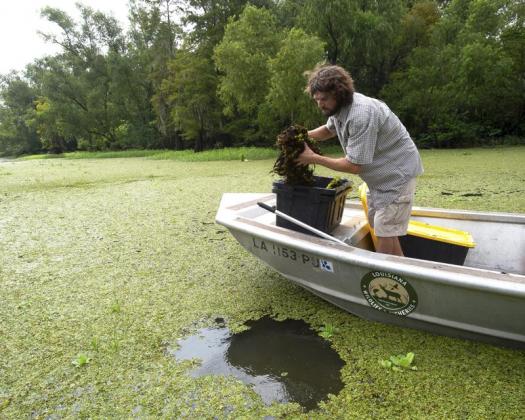
By Craig Gautreaux, cgautreaux@agcenter.lsu.edu
STEPHENSVILLE — A severe winter in Louisiana caused much of the giant salvinia in the state to die off, especially in the northern part of the state. However, the weather caused a drastic reduction of a weevil being used to control salvinia.
Charlie Wahl, an entomology research associate with the LSU AgCenter, said very few requests for weevils to help combat giant salvinia in north Louisiana have been made this year. He believes the biomass of the invasive plant has been knocked back from the cold and delayed issues caused by it in south Louisiana.
“Instead of seeing our normal infestations in late spring, we are now moving into summer before we saw our giant salvinia create big mats to where they are problematic for waterways,” Wahl said.
Because the giant salvinia appeared later this year, control of the plant through weevil introduction will also be delayed. It takes the weevils two to three months to show signs of controlling giant salvinia. If landowners or state agencies are just now introducing weevils, control of the plant may not occur in time for Louisiana’s teal season in those affected areas.
Giant salvinia can choke off submerged aquatic vegetation that serves as food and habitat for waterfowl. Because of the late infestations, Wahl believes chemical control measures will be implemented more often, a more costly approach.
“Chemical control, relying on just chemical control alone is very costly, and it is a short-term, small-scale solution to the problem,” Wahl said.
Wahl is involved with raising weevils at several locations across the state. Weevil populations in the wild and in some of his ponds were decimated by the severe cold.
“We saw a big decrease in the density of the adult salvinia weevils, and we saw a big lag time before they started reproducing and producing any larvae as well,” he said.
Common salvinia, a relative of giant salvinia, is also causing some concern.
“We are seeing more and more common salvinia,” Wahl said. “You wouldn’t find it as widespread as you would giant salvinia. This year, when we are monitoring and going out, we have actually seen an increase in common salvinia infestations around southern Louisiana.”
Wahl said the weevil that helps control giant salvinia is not effective on common salvinia.
“It can feed on common salvinia and get enough to live a little longer,” Wahl said. “But they’re not reproducing, and it’s not viable habitat to control common salvinia. Therefore, we have to rely more on chemical control for common salvinia.”
Wahl was in the Big Fork Bayou area releasing weevils to help control salvinia there and demonstrate the proper technique in releasing the weevils.
If landowners are interested in acquiring weevils to fight giant salvinia on their property, Wahl said they should contact their local Soil and Water Conservation office.
